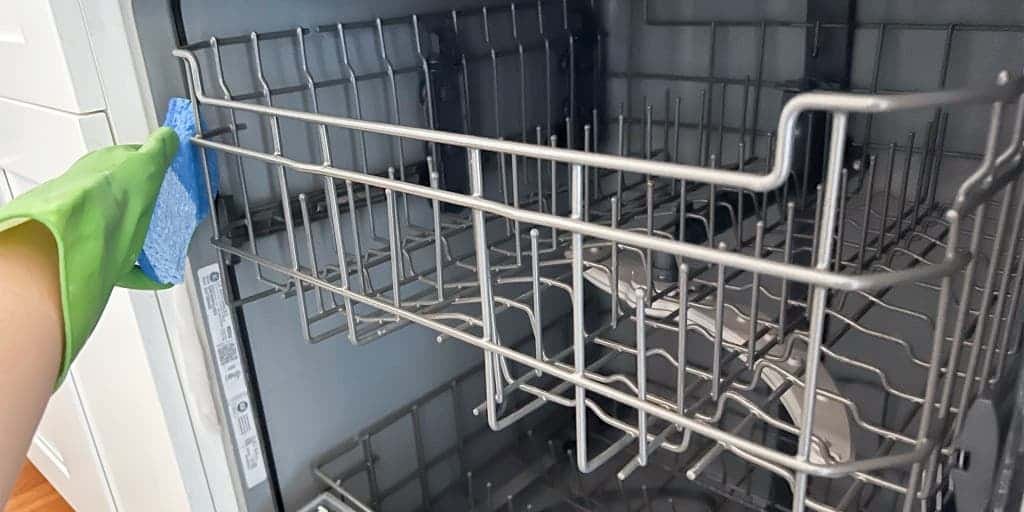To remove mold from a dishwasher, clean it with a mixture of vinegar and baking soda. Run a hot water cycle with vinegar, then sprinkle baking soda and run a short cycle.
Dealing with mold in your dishwasher is crucial for maintaining both hygiene and appliance functionality. Mold thrives in moist environments, making dishwashers a common breeding ground. Neglecting this issue can lead to unpleasant odors and could compromise your dishes’ cleanliness.
Tackling mold effectively ensures your kitchen appliance stays sanitarily sound and prolongs its lifespan. The key is to use natural, yet powerful cleaning agents that eliminate mold without damaging the dishwasher’s components.
Regular maintenance, alongside immediate action upon spotting any mold, plays a pivotal role in keeping your dishwasher mold-free. With these straightforward strategies, you can swiftly vanquish mold and keep your dishwasher pristine.

Credit: www.nytimes.com
Table of Contents
The Hidden Culprit: Mold In Your Dishwasher
Dishwashers are a modern luxury, saving precious time and effort. But a hidden enemy lurks within – mold. This unwanted guest finds a perfect home in the nooks and crannies of your dishwasher. Recognizing and eliminating mold is essential for a clean home and healthy living.
Identifying Mold: Types And Signs
Dishwashers can harbor various mold types, including black, green, and white strains. These molds pose health risks and spoil the machine’s performance. Visual checks within the dishwasher can reveal mold presence. Look for:
- Black spots or fuzzy growth on seals and at the bottom
- Unpleasant odors that persist after regular cleaning
- Difficulty in draining, often due to mold clogging the system
Why Mold Loves Dishwashers: Warmth And Moisture
Understanding why mold thrives in your dishwasher is key to preventing it. The environment inside is perfect for mold growth:
Warmth |
Moisture |
|---|---|
Hot water cycles create warmth that molds love. |
Damp conditions post-cycle provide a moist breeding ground. |
Regular cleaning and maintenance prevent mold from taking over. Empty the dishwasher soon after the cycle ends. Leave the door ajar to allow airflow. Wipe down surfaces frequently to keep them dry and inhospitable to mold.
Health Hazards Associated With Dishwasher Mold
Mold in your dishwasher isn’t just unsightly — it’s a health risk. Understanding these dangers is key to keeping your kitchen safe. Here’s a look at the specific health hazards dishwasher mold poses.
Respiratory Issues And Allergies
Mold can trigger respiratory problems. When mold spores disperse in the air, they can be inhaled, leading to symptoms such as:
- Coughing
- Sneezing
- Difficulty breathing
People with asthma or allergies may experience more severe reactions. These can include asthma attacks or allergic responses. Regular cleaning of the dishwasher is vital to prevent these issues.
Compromised Food Safety
Moldy dishwashers can be a hotbed for bacteria. This can compromise the cleanliness of your dishes. Here’s how contaminated dishes may affect you:
- Risks of foodborne illnesses increase
- Dishes and utensils may harbor harmful microbes
- Health issues can arise from ingesting mold
To avoid these risks, inspect dishes for any signs of mold before use. Adequate dishwasher maintenance and hygiene are necessary to ensure food safety.
Preventive Measures: Keeping Mold At Bay
Mold in a dishwasher can be unsightly and unhealthy. To prevent mold growth, adopt these simple yet effective strategies. They ensure a clean and safe environment.
Regular Cleaning Routines
Regular cleaning is crucial to mold prevention. Follow these steps every month:
- Empty the dishwasher.
- Remove any leftover food bits.
- Clean the filter with soap and water.
- Wipe around the door seals.
- Run a hot water cycle with vinegar.
Post-cleaning, leave the dishwasher door open for an hour to air dry.
Proper Dishwasher Ventilation
Good airflow stops mold from growing. Keep these points in mind:
- After every wash, crack the door open.
- Ensure the vent is not blocked.
- Clean the vent regularly to remove debris.
This practice prevents moisture from lingering inside.

Credit: www.reddit.com
Natural Solutions For Mold Removal
Mold in your dishwasher can be more than an annoyance; it poses health risks and can spread quickly. Natural solutions are effective in tackling mold without harming your dishwasher’s delicate ecosystem. Simple household items can become your allies in this fight.
Vinegar And Its Anti-mold Properties
Vinegar is a powerful, natural cleaner widely known for its ability to kill mold spores. Its natural acidity breaks down mold and prevents future growth. To use vinegar for mold remediation:
- Fill a dishwasher-safe container with white vinegar.
- Place it on the top rack of your dishwasher.
- Run a hot water cycle with the vinegar.
For areas with stubborn mold, apply vinegar directly and allow it to settle for 10 minutes before scrubbing.
Baking Soda’s Abrasive Action
After vinegar, baking soda is an excellent follow-up for additional cleansing and deodorizing. Its natural abrasiveness helps to scrub away mold residues without scratching surfaces.
- Sprinkle baking soda at the bottom of the dishwasher.
- Run a short cycle with hot water.
- The baking soda will scrub away traces of mold and neutralize odors.
This one-two punch approach of vinegar followed by baking soda often eliminates mold effectively. Regular maintenance with these methods will keep your dishwasher mold-free.
Chemical Warfare: When To Use Commercial Cleaners
Sometimes, natural remedies just don’t cut it. For tough mold infestations in your dishwasher, turning to commercial cleaners may be your best bet. These powerful agents are designed to obliterate mold and prevent its return, ensuring your dishwasher remains hygienic and safe. But, not all cleaners are created equal. Safe usage and effectiveness are paramount. Let’s explore how to choose and use commercial mold removers correctly.
Choosing Safe And Effective Mold Removers
Selecting the right mold remover is crucial for both your health and your dishwasher’s longevity. Look for products specifically labelled as mold and mildew removers with an EPA registration. This ensures they’re government-approved for efficiency and safety. Opt for removers that list clear usage instructions and precautions to protect you and your appliance. Always wear gloves and a mask, and ensure your kitchen is well-ventilated during the cleaning process.
- EPA-registered: Guarantees effectiveness and safety
- Clear label: Details on usage and precautionary measures
- Wear protective gear: Essential for safety while handling chemicals
The Right Way To Use Bleach Solutions
Bleach is a strong ally against mold but requires careful handling. Never mix bleach with other cleaners, as dangerous fumes can result. For a homemade solution, mix one cup of bleach with a gallon of water. Remove any visible food debris from your dishwasher, then run a full cycle with the bleach solution poured into the bottom. Afterward, ventilate and run another cycle with just water to rinse any remaining bleach away.
Step |
Instruction |
|---|---|
1 |
Ensure dishwasher is empty |
2 |
Mix bleach solution carefully |
3 |
Run full cycle with bleach solution |
4 |
Ventilate and rinse with water cycle |
Note: Bleach should be a last resort and used only when mold persists after trying other cleaners. For dishwashers with stainless steel interiors, avoid bleach as it can corrode and damage the surface.
Deep Cleaning Your Dishwasher
Mold in your dishwasher isn’t just unsightly; it can also smell bad and affect your dishes. Fear not, a thorough deep clean will tackle the problem head-on. This section will guide you through dismantling and cleaning key components. Let’s get started!
Step-by-step Guide To Dismantle And Clean
- Unplug the dishwasher or turn off the circuit breaker to ensure safety.
- Remove the bottom rack to access the dishwasher floor.
- Take out the spray arms by unscrewing or unclipping them.
- Locate and extract the filter found under the spray arm.
- Clean the interior using a baking soda paste or vinegar solution.
- Scrub the parts you’ve dismantled with a soft-bristle brush.
- Rinse all components thoroughly with warm water.
- Reassemble the parts in reverse order once they’re dry.
- Run a cleaning cycle with a dishwasher-safe mold remover or white vinegar.
Special Focus On Filter, Gasket, And Spray Arms
Certain parts of your dishwasher need extra attention during cleaning:
- Filter: Remove and soak it in a vinegar solution for 10 to 15 minutes. Scrub off any buildup.
- Gasket: Wipe the door gasket with a vinegar-soaked cloth. Inspect it for damages that might need professional attention.
- Spray Arms: Use a toothpick to clear the holes. Soak them in vinegar if you notice mold.
Reassembling these pieces should be done carefully. Make sure they fit securely back in place to prevent water from leaking out during the next wash cycle.
Tip: Prevent mold by periodically examining and cleaning these components. Keep your dishwasher fresh and hygienic!
Maintenance Tips For A Mold-free Dishwasher
Combatting mold in dishwashers begins with regular upkeep. Mold thrives in moist, warm environments, but with the right maintenance routines, you can keep your dishwasher clean and safe. Follow these easy steps to maintain a hygienic, mold-free appliance.
Regular Checks And Cleaning Schedules
To prevent mold growth, mark your calendar for routine inspections and cleanings. Here are some quick tips:
- Inspect weekly for any signs of mold.
- Clean with a vinegar solution bi-weekly.
- Use baking soda for a deeper clean monthly.
Remove and scrub racks and utensils holders to stop mold build-up in hidden areas.
The Importance Of Drying After Each Cycle
After each wash, drying is crucial. Letting moisture sit is an invitation for mold. Follow these drying tips:
- Leave the door open after cleaning cycles.
- Wipe down the interior with a dry, clean cloth.
- Check the seal and door area, dry them thoroughly.
Always ensure the dishwasher is completely dry before closing the door.
Professional Help: When To Call The Experts
Dealing with mold in a dishwasher can sometimes go beyond simple home remedies and quick fixes. Professional help becomes necessary when mold persists despite your best efforts. It’s essential to understand when it’s time to pick up the phone and seek expert assistance.
Recognizing Persistent Mold Problems
Mold keeps coming back after multiple cleanings.
You notice a strong moldy odor that won’t go away.
Your dishwasher shows signs of damage, like cracked parts where mold hides.
Anyone in your home starts having health issues that could be mold-related, like allergies.
Services Offered By Appliance Professionals
Appliance professionals give your dishwasher a thorough inspection, identifying hidden mold.
- They use specialized tools and products to remove mold effectively.
- A complete sanitization process is applied to kill all spores.
- They might replace damaged components that harbor mold and prevent recurrence.
- Professionals will give you tips on preventing mold growth in the future.

Credit: www.reddit.com
FAQ
How Do I Get Rid Of Black Mold In My Dishwasher?
To remove black mold from your dishwasher, first, run an empty cycle with vinegar. Then, scrub the interior with baking soda and follow up with another empty cycle. Regularly clean the filter and seals to prevent mold growth.
Why Is Mold Growing In My Dishwasher?
Mold grows in dishwashers due to trapped moisture, food particles, and warm temperatures. Regular cleaning and drying after use can prevent mold buildup.
Can Mold Be Killed In Dishwasher?
Yes, mold can be killed in a dishwasher. Use high heat and a dishwasher-safe mold-removal product for best results. Regular cleaning also prevents mold growth.
Why Is Black Mold Coming Back In My Dishwasher?
Black mold returns in dishwashers due to persistent moisture and food residue. Ensure thorough cleaning and drying to prevent regrowth.
Bottom Line
Banishing mold from your dishwasher is essential for your health and your appliance’s longevity. Regular cleaning with vinegar, baking soda, or bleach can work wonders. Remember to keep it dry, and always tackle spills promptly. By maintaining a mold-free environment, your dishes will sparkle, and your kitchen will stay fresh and sanitary.
Stay on top of these simple tips for a spotless dishwasher free of unwanted fungal guests.



